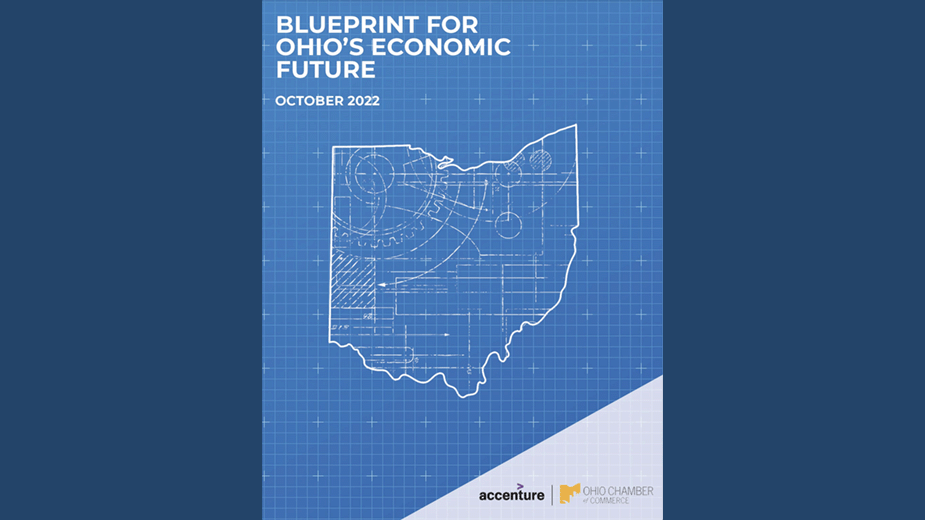Column | Blueprint for Ohio’s Economic Future Identifies Key Growth Opportunities
By Steve Stivers, president and CEO of the Ohio Chamber of Commerce.
Ohio has long been a state that sees – and seizes – opportunity and innovation. From the Wright Brothers exploring flight to the evolution of the automobile and the invention of the traffic light, Ohio has been a place for new ideas that shape our society.
Today, Ohio is home to 200 corporate headquarters and 55 Fortune 1000 companies, and Intel’s recent decision to invest in Ohio points to a future as the Silicon Heartland.
The governor and state Legislature have done an outstanding job marshalling Ohio’s resources to benefit our state’s economy. While there is much to be proud of based on where we currently stand, we can also take additional steps to lay the foundation for continued investment and creating economic and business growth.
The state of Ohio, like the nation, is navigating complex challenges that include a decline in population, persistent urbanization, a lack of childcare resources and a shortage of talent in its workforce. Recent national rankings – which placed Ohio near the bottom of the pack in terms of two categories, business friendliness (47th) and tax burden (37th) – underscore the importance of addressing these challenges.
The state is at a critical juncture, with an urgent need to move forward. Ohio must take steps now to remain one of the most competitive states for businesses while laying the foundation for future growth. The Ohio Chamber of Commerce is leading through both its legislative agenda and its role as the convener of business. In collaboration with Accenture, the Ohio Chamber of Commerce Research Foundation in October unveiled its Blueprint for Ohio’s Economic Future, a long-term strategic report that analyzes Ohio’s economic outlook and compares it to that of other states.
In this report, the Ohio Chamber set out to explore Ohio’s current strengths, gaps and opportunities of the state’s business climate. Using in-depth secondary research and in-person workshops, the team examined the factors that are key to Ohio’s ability to continue to attract residents and businesses, nurture a larger, more effective workforce and make Ohio the best state in the country to do business – competitive with any place in the world.
The Blueprint highlights six key areas, or “levers,” where Ohio’s rankings stand to gain relative to other states: Workforce & Education, Sense of Place, Taxes & Costs, Innovation & Collaboration, Business Friendliness, and Infrastructure. Within each of these levers, a deeper dive reveals the strategic indicators that are associated with those rankings and how Ohio measures against our competition. Based on the analysis of the data, the Ohio Chamber will lead in shaping the state’s future and offers this report as a starting point to bring together leaders in business, economic development, workforce, education, housing, health care and transportation, as well as other community representatives.
The research provides examples of opportunities for improvement in the near term and as a foundation for sustained growth in the future. The uncertainty of global events that were previously hard to fathom, like those that we have experienced in the past two years with COVID-19, further underscores the importance of a “living” strategy that proves adaptable and resilient over time, allowing for continuous innovation and improvement in line with the evolving priorities and values of Ohioans.
For example, one of the key levers in the Blueprint is Workforce & Education. Ohio’s workforce reality is that the state’s population growth isn’t keeping up to that of its peers. The COVID-19 pandemic has only exacerbated this dynamic. From 2020 to 2021, Ohio’s population declined by nearly 10,000 people. While some states’ population growth slowed, only one-third of states saw population totals decrease. Ohio’s sluggish growth can be attributed to an aging population, declining immigration and “brain drain.” By contrast, the South and the West were home to both the fastest-growing states and cities.
Ohio has a wealth of career opportunities in multiple sectors, and it will be essential for policymakers to match the skills needed to fill those jobs with the development pipeline of K-12 education, higher education and talent attraction efforts. We are grateful for the leadership of the DeWine administration in this area, through the creation of programs such as TechCred and Ohio BUILDS, which emphasize workforce development and upskilling for industries in search of a broader pool of workforce talent. In the Blueprint, the Chamber highlights a number of recommendations that will reduce barriers to entry for those who are seeking to join or rejoin the workforce, including:
• Removing childcare as a barrier for caregivers and working parents.
• Pursuing strategies to alleviate public assistance benefits cliffs.
• The Ohio Chamber supporting and leading a robust Business-Education Network.
• Promoting employer-led, work-based training.
• Reskilling midcareer workers and creating opportunities for older workers.
• Considering recruitment campaigns, incentives and advocacy to recruit and retain top talent.
Another lever of note contained in the Blueprint is in the area of taxation. Ohio is one of only 17 states that allow for municipalities to impose a local income tax. At 848 local government income tax jurisdictions, Ohio is second only to Pennsylvania in total number of local taxing authorities. The Blueprint provides a number of recommendations that will make Ohio more competitive in this area and allow the state to target comprehensive tax reform.
The report recommends:
• Conducting a comprehensive review of state and local tax liabilities for businesses, including property, sales and excise, gross receipts, local net profit, corporate license, unemployment insurance and individual income taxes paid by owners of pass-through entities.
• Analyzing any proposed tax changes to consider the impact on services that benefit businesses and communities, such as education, public safety and infrastructure.
• Creating robust one-stop shops, including conducting further analysis on the Ohio Business Gateway, to better relieve the administrative burden of taxes, licenses and fees on businesses.
These are just a few examples of the recommendations contained in the Blueprint for Ohio’s Economic Future. The more than 80-page Blueprint report contains a comprehensive analysis on where Ohio’s economic competitiveness stands today and provides detailed recommendations on how we can improve upon the studied metrics.
The Ohio Chamber of Commerce operates with a simple and compelling vision: Making Ohio the best place in which to do business anywhere in the world. As the leading Ohio business advocate and resource, the Ohio Chamber supports free enterprise, economic competitiveness and growth for the benefit of all Ohioans.
Maintaining and improving Ohio’s business environment is a constant effort. To remain competitive nationally, we must examine our current environment with an eye to best practices. The Ohio Chamber believes the Blueprint will allow us to do just that.
Published by The Business Journal, Youngstown, Ohio.



